
A nest is a structure built for certain animals to hold eggs, offspring, and, oftentimes, the animal itself. Although nests are most closely associated with birds, members of all classes of vertebrates and some invertebrates construct nests. They may be composed of organic material such as twigs, grass, and leaves, or may be a simple depression in the ground, or a hole in a rock, tree, or building. Human-made materials, such as string, plastic, cloth, or paper, may also be used. Nests can be found in all types of habitat.

Wasps in the family Pompilidae are commonly called spider wasps, spider-hunting wasps, or pompilid wasps. The family is cosmopolitan, with some 5,000 species in six subfamilies. Nearly all species are solitary, and most capture and paralyze prey, though members of the subfamily Ceropalinae are kleptoparasites of other pompilids, or ectoparasitoids of living spiders.

A wasp is any insect of the narrow-waisted suborder Apocrita of the order Hymenoptera which is neither a bee nor an ant; this excludes the broad-waisted sawflies (Symphyta), which look somewhat like wasps but are in a separate suborder. The wasps do not constitute a clade, a complete natural group with a single ancestor, as their common ancestor is shared by bees and ants. Many wasps, those in the clade Aculeata, can sting their insect prey.

Pompilus cinereus, the leaden spider wasp is the most widespread species of the Pompilus spider wasps, and throughout a large proportion of its wide distribution is the only species of Pompilus. It is the type species of the genus Pompilus and therefore of the family Pompilidae.

Anoplius is a genus of spider wasps in the family Pompilidae, called the blue-black spider wasps.
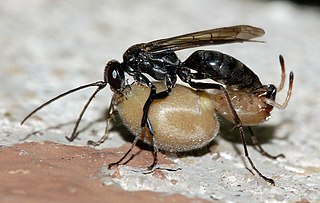
Auplopus carbonarius is a spider wasp of the family Pompilidae. Uniquely among the British group it constructs a nest of barrel-shaped cells in which spiders are stored and the larvae develop.
Cryptocheilus notatus is the largest species of spider wasps (Pompilidae) to be found in Great Britain reaching up to 18mm in length.
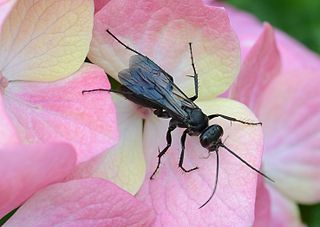
Anoplius nigerrimus is one of the most common spider wasps, or pompilids, in Europe. They are mostly black and the females are 6-8 mm long while males measure 5-8 mm. This species may be distinguished from the related Anoplius concinnus and Anoplius caviventris by the 20 setae, or hairs, on the forehead rather than 60 or 45.
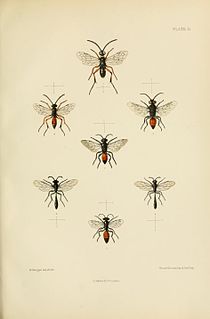
Ceropales maculata is a kleptoparasitic spider wasp found in the holoarctic region.

Cryptocheilus australis, the golden spider wasp, is an Australian pepsid spider wasp that was accidentally introduced to New Zealand around 1960.
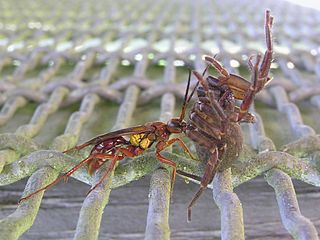
Sphictostethus nitidus, the golden hunter wasp or red spider wasp, is a species of pepsid spider wasp endemic to New Zealand.

Evagetes is a genus of spider wasps from the family Pompilidae. There are 72 described species, of which 58 are found in the Palaearctic region, 11 in the Nearctic region, with a few penetrating to the Afrotropical, Oriental and Neotropic regions. Evagetes wasps are kleptoparasitic on other pompilid wasps, especially the genera Arachnospila, Anoplius, Episyron and Pompilus, digging into their sealed burrows, eating the host egg and replacing it with an egg of its own. Evagetes wasps are characterised by their very short antennae. Most are species are black with the base of the antennae rufous, several Evagetes species are very metallic bluish insects.
Evagetes crassicornis is a kleptoparasitic spider wasp with a holarctic distribution.
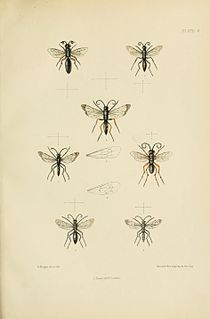
Agenioideus cinctellus is a spider wasp of the subfamily Pompilinae with a Palearctic distribution.

Anoplius viaticus, commonly known as the black-banded spider wasp, is a species of spider wasp. These wasps are known as spider wasps because the females capture spiders to provide their offspring with food. The paralysed spider is cached in a burrow, the wasp lays an egg on it, and when this hatches, the developing wasp larva consumes the spider. This species is found in sandy heathland across most of Europe.

Anoplius concinnus is a widespread Eurasian species of spider wasp.

Tachypompilus analis, the red-tailed spider wasp is a species of spider wasp found in most of tropical and subtropical Asia, north to Japan. These spider wasps often hunt huntsman spiders.

Tachypompilus ferrugineus, the rusty spider wasp, red-tailed spider hunter, or sometimes red-tailed spider wasp is a species of spider wasp from the Americas. It preys mainly on wandering spiders, especially wolf spiders.

Poecilopompilus algidus is a species of spider wasp which is widespread in the Americas.
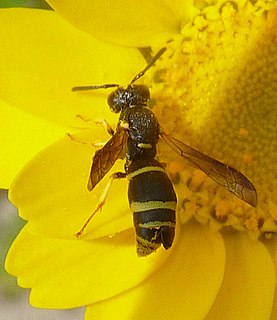
Odynerus spinipes, the spiny mason wasp, is a species of potter wasp from western Europe. It is the type species of the genus Odynerus, being first described by Carl Linnaeus in his landmark 1758 10th edition of Systema Naturae.

















